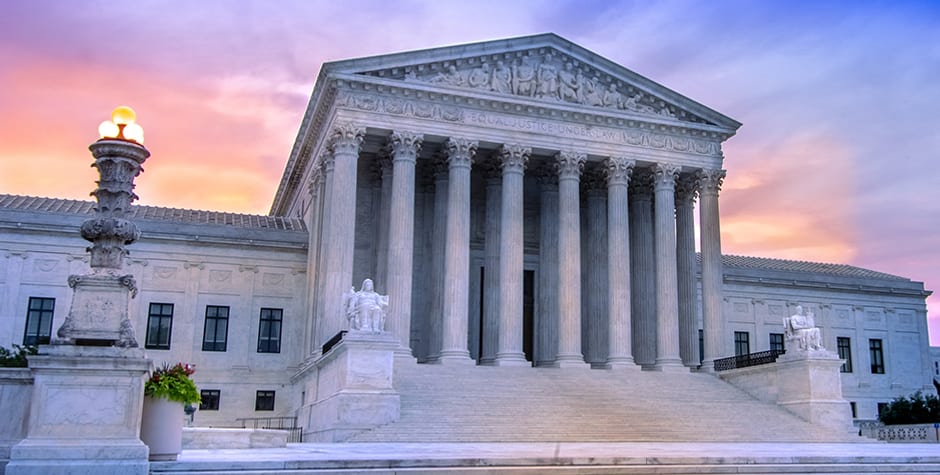The ACLJ Files Amicus Brief With Supreme Court Asking Court To Cut Back the Administrative Bureaucracy’s Expansive Powers
The ACLJ just filed an amicus brief with the Supreme Court of the United States in a major case challenging a key component of the administrative state’s power. The case, Loper Bright Enterprises v. Gina Raimondo appears at first glance rather dull, but it could effect massive change by allowing judges to rein in the seemingly limitless power of, what the ACLJ has come to term, the Deep State.
It involves an arcane question about who should pay the salaries of federal monitors who ride in private fishing vessels for the purpose of making sure that the fishermen comply with federal laws governing fisheries on federal waters. But the far weightier issue is whether administrative agencies – the bureaucracy – should have the power to make up federal law when Congress has not specifically addressed an issue. In Loper, Congress never said who should pay the salaries of the fishing boat monitors. The law was silent. You would think that since the monitors are working on behalf of the federal government, the government should pay them. But a federal agency decreed that the fishing vessels should pay.
As we have often discussed, the administrative bureaucracy in Washington wields ever-increasing power over Americans. One of the ways the administrative bureaucracy does so is by enacting virtually thousands of regulations filling in gaps where Congress has not spoken. This is not how the Founders intended the government to work. To preserve individual liberty, the Founders divided up power between the Executive branch, the Legislative branch, and the Judiciary. James Madison explained that “no political truth is certainly of greater intrinsic value or is stamped with the authority of more enlightened patrons of liberty than [the separation of powers]. The accumulation of all powers, legislative, executive, and judiciary, in the same hands, …may justly be pronounced the very definition of tyranny.” Unfortunately, this is exactly what the bureaucracy – sometimes known as the fourth branch of government – has become.
The Founders intended each of the three branches of government outlined in the Constitution to jealously guard its own power. And they intended the most politically accountable branch of government, the Legislative branch, to pass laws. But that is not how most federal laws in modern times are enacted. The administrative bureaucracy adopts laws by filling in gaps that Congress left in the federal statutes it does pass. And there are a lot of gaps. And even when there are no gaps, agencies sometimes make them up and shoehorn their preferred policy into the imagined gaps. Remember the Biden student loan forgiveness program and the COVID vaccine mandate?
The administrative bureaucracy’s exponential growth in power is due in part to a Supreme Court case decided almost 40 years ago, Chevron U.S.A., Inc. v. Natural Resources Defense Council, Inc. In that case, the Court held that it was fine for administrative agencies to fill in gaps. Chevron conferred on agencies the power to “speak with the force of law when [they] address ambiguity in the statute or [fill] a space in the enacted law.” And to make matters worse, federal courts were required to defer to the agency interpretations of federal statutes. This has become known as “Chevron deference” and continues to hamstring judges, requiring them to defer to administrative agencies instead of applying the law as written by Congress.
In our amicus brief urging the high Court to overrule Chevron, we argued that Chevron bore significant responsibility for the growing tyranny threatened by the administrative bureaucracy. Chevron “gives Congress carte blanche to enact ambiguous legislation, and implicitly condones expansive delegations of authority to fill in gaps. Chevron effectively rewards Congressional abdication of responsibility.”
We also argued that Chevron violates the separation of powers because it “effectuated a seismic shift in power to the Executive branch from the Legislative and Judicial branches of government. Chevron runs afoul of both Congress’s Article I power to set national policy and the federal judiciary’s Article III power of judicial review.”
We explained further that Chevron “divests the authority of the judiciary to interpret federal law. Interpreting ambiguous federal statutes that are administered by an agency requires the courts to exercise independent judgment. Chevron hamstrings judges from exercising that judgment by allowing administrative agencies to adopt any interpretation that is marginally reasonable — even if it does not reflect the best view of the statute.”
At least four Justices have been critical of Chevron in other contexts. Hopefully, at least five Justices will agree when Loper is decided next term that it is time for Chevron to go.
